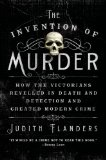Summary | Excerpt | Reviews | Beyond the Book | Readalikes | Genres & Themes | Author Bio

How the Victorians Revelled in Death and Detection and Created Modern Crime
by Judith Flanders
Another way to savour the thrill of murder was to attend the funerals of the victims. Many people did so out of respect, as friends or as members of the same community. But far more did so out of curiosity. Still more read about them afterwards. Even four hundred miles away the Caledonian Mercury gave a detailed account of the funeral of the murdered apprentice: its readers were able to follow the precise path of the cortège as it travelled 'from Ratcliffe-highway, through Well-close-square, up Well-street, to Mill-yard'. In Hull too newspaper readers followed the crowds that turned out for the Marrs' triple funeral: 'The people formed a complete phalanx from the [Marrs'] house to the doors of St. George's church.' The church itself was so crowded that the funeral procession could only enter 'with some difficulty'. Then the paper gave the order of the procession, as was normally done for royal weddings and funerals, or the Lord Mayor's parade:
The body of Mr. Marr;
The bodies of Mrs. Marr and infant;
The father and mother of Mr. Marr;
The mother of Mrs. Marr;
The four sisters of Mrs. Marr;
The only brother of Mr. Marr …
The friends of Mr. and Mrs. Marr.
Newspapers churned out stories, handbills circulated, witnesses were questioned. But none of this got any closer to finding the murderer or murderers. Then, like a recurring nightmare, twelve days after the Marrs' deaths it all happened again. On 19 December a watchman found John Turner, half-dressed and gibbering with fear, scrambling down New Gravel Lane, a few hundred yards from the Ratcliffe Highway. He had gone to bed early at his lodgings above a public house. After closing time he heard screaming and he went part-way down the stairs, where he saw a stranger bending over a body on the floor. After a panicky attempt to leave via the skylight (he was so frightened he couldn't find it), Turner tied his bedsheets together and slid out of the window into the yard, shouting, 'They are murdering the people in the house!' The watchman was quickly joined by neighbours, and they broke in through the cellar door to find, yet again, bodies lying with their heads beaten in and their throats cut. The body of John Williamson, the publican, was in the cellar; his wife Elizabeth had been in the kitchen with their servant Bridget. Only the Williamsons' granddaughter, asleep upstairs, had escaped. Once more, money was scattered about, but little of value had been taken; once more, the escape was via the back door and over the yard fence.
The funeral of the murdered Marr family as it processed through the East End. The funeral mutes with their staffs and the coffins topped by plumes were watched by residents lined all the way along the route, which had been publicized by the newspapers.
The newspapers covered the story widely, but the information they gave was not terribly helpful. The Edinburgh Annual Register described John Turner as being 'about six feet in height', while The Times said he was 'a short man' with 'a lame leg'. The Morning Chronicle described his 'large red whiskers', but thought he was 'about five feet nine inches' and 'not lame'. Turner, therefore, was either tall, short, or in-between; he was lame, or possibly not; and he had large red whiskers, unless he didn't. This was the description of a man who had stood in front of journalists at an inquest. Imagine how reliably the papers described the man briefly seen by Turner, or those who had been glimpsed running away from the Marrs' house.
The police had no more idea where to look for the perpetrators of this new outrage than they had had after the deaths of the Marrs. They arrested plenty of people: people who were violent; people who looked in some way suspicious; people against whom a grudge was held. But one by one they were questioned and released.* In small communities criminals were usually revealed fairly swiftly; in areas with larger populations, handbills with descriptions of the wanted person and offers of rewards generally brought in information, frequently from fellow criminals who found this a convenient way of earning a bit of cash and removing a competitor at the same time. With no response to the initial reward offered after the murder of the Marrs, the only thing the magistrates could think to do was increase the sum. To the initial £50 reward, another £100 was added by the Treasury, and that was increased two days later to an astonishing £700 – a very comfortable middle-class annual income, the sign of increasing government anxiety, verging on panic. After the Williamsons were murdered, another 120 guineas was offered: twenty guineas to anyone who could identify the owner of the weapons, and 100 guineas more if that person were to be convicted of the murders.
From Invention of Murder by Judith Flanders. Copyright © 2013 by the author and reprinted by permission of St. Martin's Press, LLC
Your guide toexceptional books
BookBrowse seeks out and recommends the best in contemporary fiction and nonfiction—books that not only engage and entertain but also deepen our understanding of ourselves and the world around us.